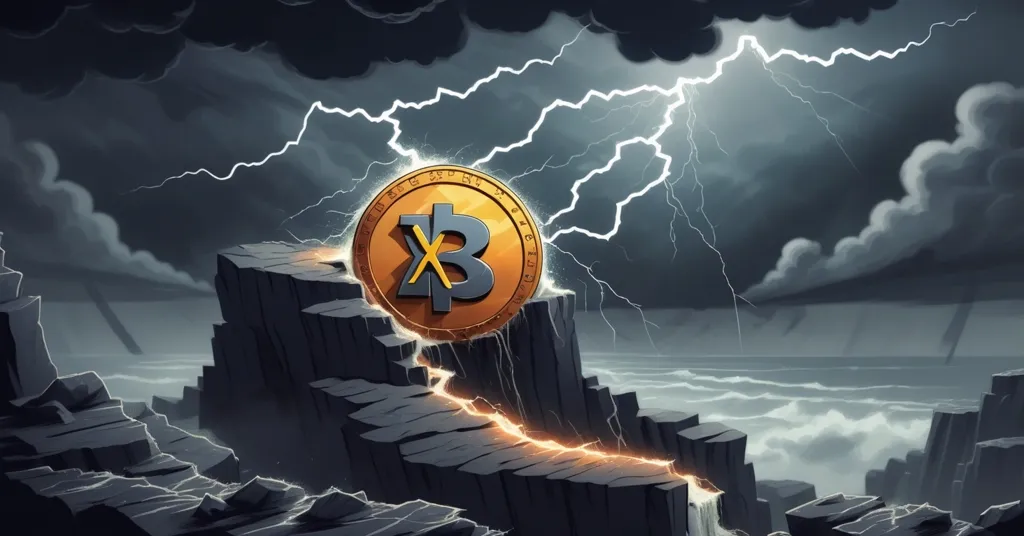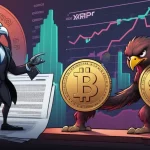XRP Price Plunge: 15% Drop on August 2 Amid Bitcoin Pullback and Hype Scrutiny

XRP Price Prediction Under Scrutiny: Sorting Fact from Fiction for August 2
Ripple’s XRP has been caught in a brutal downdraft, shedding over 15% of its value in the past week as Bitcoin pulls back from reported record highs. As of August 2, we’re slicing through the speculative haze to deliver a grounded look at XRP’s price movements, technical signals, and the broader forces at play—without the usual crypto hype or empty promises.
- Price Plunge: XRP down 15% in a week, trading near $3 after a low of $2.89.
- Bitcoin’s Shadow: BTC’s retreat from a reported $123,000 high drags altcoins down.
- Key Markers: Support at $2.89, resistance at $3.10, with conflicting technical signals.
XRP’s Recent Slide: What Sparked the 15% Drop?
The crypto market is a merciless battlefield, and XRP is taking heavy casualties. As of August 2, this altcoin—known for its rapid transaction speeds and focus on cross-border payments—is hovering around $3 after dipping to a painful low of $2.89. That’s a staggering 15% loss in just seven days, and the trigger is no mystery: Bitcoin, the undisputed heavyweight of crypto, has reportedly pulled back from an eye-watering peak of $123,000. When BTC stumbles, altcoins like XRP don’t just trip—they faceplant. But before we get lost in the quicksand of daily price predictions like those circulating for XRP’s outlook on August 2, let’s anchor ourselves in hard data and poke holes in the obsession with short-term crystal ball gazing that plagues this space.
Let’s break down the current price landscape. XRP’s $2.89 level is seen as critical support (a price point where buying interest often prevents further drops). If it holds, we might see some breathing room; if it snaps, expect more pain. On the upside, resistance looms at $3.10 (a barrier where selling pressure tends to halt rallies). Breaking through that could signal a flicker of bullish hope, but don’t hold your breath. This tug-of-war isn’t just about XRP—it’s a symptom of a Bitcoin-driven market where altcoins are often at the mercy of the king’s mood swings.
Technical Analysis: A Mixed Bag of Signals
Diving into the charts, the technical indicators for XRP are a mess of contradictions, per data pulled from platforms like Investing.com’s XRP analysis for August 2. The Relative Strength Index (RSI), a tool to gauge if a coin’s overbought or oversold, sits in neutral territory—think of it as the market shrugging its shoulders with no clear panic or greed in sight. Meanwhile, the Moving Average Convergence Divergence (MACD) tilts bearish, suggesting downward momentum might stick around. Yet, the Stochastic oscillator and Average Directional Index (ADX) throw a curveball, hinting at potential buying interest and a strengthening trend. Confused? Good. That’s the reality of relying on these tools—they’re guides, not gospel, and often clash like drunk uncles at a family reunion.
Then there’s the Average True Range (ATR), which measures volatility. Right now, it’s signaling low price swings in the short term, so don’t bet on any dramatic “to the moon” or “total collapse” moments today—unless the market decides to flip the script, which happens more often than we’d like. Based on this jumble, three scenarios are being floated for XRP on August 2: a bullish push above $3.10 to hit $3.20 if optimism kicks in; a neutral drift between $2.95 and $3.05, basically doing nothing; or a bearish tumble below $2.89 to $2.80 or worse if support crumbles. Sounds neat and tidy, right? Here’s the ugly truth: these are educated stabs in the dark, not certainties. Crypto markets mock precision, and XRP’s history of erratic swings—often tied to legal headlines or random sentiment—proves no chart can predict the next bombshell. For more detailed breakdowns of these key price levels and technical signals for XRP, there are resources worth exploring.
Beyond the Charts: Ripple’s Unique Role and Risks
Now, let’s step back from the price noise and unpack what XRP even is. Developed by Ripple Labs, XRP aims to revolutionize cross-border payments with transactions that settle in seconds at a fraction of the cost of traditional systems. It’s partnered with financial institutions—think banks and payment providers like MoneyGram—carving a niche that Bitcoin, with its focus on being a decentralized store of value, doesn’t touch. BTC is the rebel flipping off centralized finance; XRP is more like a suit trying to work within the system, as shown through Ripple’s partnerships for efficient payments. And that’s where the friction lies. Ripple Labs holds a massive chunk of XRP’s total supply, making it far more centralized than Bitcoin or even Ethereum. For decentralization purists, that’s a glaring red flag in a space built on the ethos of freedom and privacy.
Then there’s the 800-pound gorilla: Ripple’s legal battle with the U.S. Securities and Exchange Commission (SEC). Since 2020, the SEC has argued XRP should be classified as a security, not a currency, which would slap it with stricter regulations. A ruling against Ripple could cripple XRP’s adoption and tank its price overnight—something no RSI or MACD line can forecast. While no major updates have broken as of August 2, this ongoing uncertainty hangs like a guillotine over every XRP holder. For deeper discussions on the potential outcomes, platforms like Quora host debates on the SEC lawsuit’s impact on XRP. It’s a reminder that betting on altcoins isn’t just about market trends; it’s about navigating landmines that could detonate at any moment.
Bitcoin’s Dominance: The Ripple Effect on Altcoins
Let’s address the elephant in the room: Bitcoin’s outsized influence. The reported $123,000 peak—though I’ll note real-world data as of early 2024 pegs BTC’s historical high closer to $73,000, so take this figure with a grain of salt—allegedly sparked profit-taking that rippled across the market. Analyst Axel Adler from AInvest.com highlights Bitcoin’s correction and its effect on altcoins like XRP. He points out a fascinating shift: long-term BTC holders (whales) have dumped 502,000 coins over the past year, yet institutional demand is stepping in to stabilize the market. That’s a nod to effective accelerationism (e/acc), the push for tech like crypto to barrel forward and upend the status quo. Bitcoin’s growing maturity is a win for decentralized money, but altcoins like XRP aren’t reaping the same benefits. When investors flee to safer harbors during BTC wobbles, smaller coins get left in the dust, bleeding value with little buffer.
This dynamic isn’t new. Bitcoin has always been the market’s compass, and its consolidation phases often spell chaos for altcoins. XRP’s 15% drop isn’t an isolated fluke—it’s part of a pattern where BTC’s gravitational pull dictates the fate of lesser assets. For altcoin holders, it’s a harsh lesson: you’re not just investing in XRP; you’re betting on Bitcoin’s stability too. And with $751 million in crypto liquidations reported in a single day by outlets like CryptoSlate, the stakes couldn’t be clearer.
The Hype Trap: Why Price Predictions Are Often Junk
Now, let’s cut to the chase on these shiny XRP price predictions for August 2. I’m calling it like I see it: most are glorified clickbait. Self-styled “experts” toss out exact targets like $3.20 or $2.80 as if they’ve got a direct line to the future. Spoiler—they don’t. Short-term price analysis can sketch a rough map, but it’s no guarantee. XRP’s fate hinges on a web of factors beyond any chart: market mood, regulatory nukes, or even a stray tweet from a billionaire with too much time on his hands. Historically, XRP has spiked and crashed on legal news alone—look at the 2017 bull run or the 2020 SEC lawsuit drop. No indicator predicted those with pinpoint accuracy, and today’s guesses won’t either.
Community sentiment only fuels the chaos. Scrolling through Reddit threads discussing XRP’s recent price drop tied to Bitcoin’s influence, you’ll find a bipolar mix of blind hope and sheer panic. One user boasts, “I sold it all for XRP, we’re going to the moon,” while another laments, “I wanna get my money out before I lose more.” That emotional seesaw drives markets as much as any technical signal, and it’s a stark warning against getting sucked into FOMO or despair. Trading on gut feelings or internet hype is how you get rekt—full stop.
Bitcoin Maximalism vs. Altcoin Niches: Where XRP Fits
From a Bitcoin maximalist standpoint, XRP’s centralized structure is a dealbreaker. BTC is the unassailable fortress of decentralization, a middle finger to banks and governments, backed by a network no single entity controls. XRP, with Ripple Labs pulling the strings on supply and direction, feels like a betrayal of crypto’s core promise. Add the SEC lawsuit, and it’s hard to see XRP as anything but a risky sideshow compared to Bitcoin’s slow-but-steady march toward institutional legitimacy. For those curious about XRP’s background and mechanics, resources like Wikipedia’s explanation of XRP provide a solid primer.
Yet, I’ll play devil’s advocate: XRP’s focus on payments fills a gap Bitcoin shouldn’t stretch to cover. BTC doesn’t need to be a settlement layer for cross-border transfers—that’s not its fight. Altcoins like XRP or Ethereum, with its smart contract empire, can tackle niche use cases while Bitcoin holds the line as a store of value. Ripple’s real-world partnerships, like those with financial heavyweights, show XRP has utility, even if it’s not the hill I’d die on. Community discussions on platforms like Reddit’s XRP subreddit often validate these key price levels of $2.89 support and $3.10 resistance while sharing expert takes. Still, utility doesn’t erase the dark side: volatility, legal risks, and the ever-present threat of scams or hype cycles burning uninformed investors. XRP isn’t a fraud, but it’s a gamble in a way Bitcoin, with its battle-tested resilience, rarely is.
Key Takeaways and Questions: Cutting Through the Noise
- What’s driving XRP’s 15% drop over the past week?
Bitcoin’s reported pullback from a $123,000 high has rattled the broader crypto market, hammering altcoins like XRP with smaller market caps and higher risk exposure. - How reliable are XRP’s key price levels of $2.89 support and $3.10 resistance?
They’re based on recent trading patterns, but crypto’s unpredictability means they’re not ironclad—news or sentiment can shatter these thresholds in a heartbeat. - Can technical indicators predict XRP’s next move on August 2?
Only as a rough hint; RSI, MACD, and others give mixed signals for XRP, and they often lag behind real market shifts, making them far from foolproof. - Should you trust today’s XRP price predictions of $3.20, $2.95-$3.05, or $2.80?
Take them with a massive grain of salt—these are speculative at best, and acting on them without deep research or risk management is a fast track to losses. - What impact does XRP’s centralization and SEC lawsuit have on its outlook?
Ripple Labs’ control over XRP supply and the unresolved SEC case—potentially classifying it as a security—create massive uncertainty, undermining trust compared to decentralized giants like Bitcoin. - Is XRP still a contender despite Bitcoin’s dominance?
It has a niche in fast, cheap payments with real-world partnerships, but centralization and legal risks make it a far shakier bet than BTC’s proven decentralized model.
Looking Ahead: XRP’s Rocky Path Forward
XRP’s saga on August 2 mirrors the crypto world’s dual nature—brimming with potential yet fraught with peril. Bitcoin is forging a decentralized future, a battering ram against traditional finance, and its institutional adoption signals a tipping point we can’t ignore. Altcoins like XRP can carve out roles, but not without glaring caveats: centralization, regulatory storms, and wild price swings. Forget the mirage of pinpoint predictions; zero in on fundamentals, legal undercurrents, and market psychology. That’s where the real battle unfolds. We’re all for accelerating adoption and disruption, but let’s do it with clear eyes—hype is the enemy, and sobriety is your shield. No bullshit, just the unvarnished truth.



